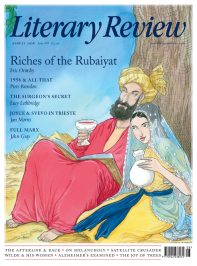Kevin Jackson
Sadland
Melancholy: Melankólia
By László F Földényi (Translated by Tim Wilkinson)
Yale University Press 341pp £20
‘Melancholy’: nowadays, the very word has a whiff of lavender, like ‘farthing’ or ‘antimacassar’ or ‘fainting couch’ or ‘the wilts and the vapours’. And yet, as all bookish connoisseurs of gloom will be aware, this apparently antiquarian subject has become remarkably fashionable over the last few decades: think of Julia Kristeva’s Black Sun, or W G Sebald’s The Rings of Saturn, or Susan Sontag’s Under the Sign of Saturn, the title essay of which is a reimagining of Walter Benjamin, the grandfather of cultural studies, as less an idiosyncratic Marxist than a grand master of melancholy.
László Földényi is a leading Hungarian academic philosopher and art critic, and his hefty addition to this modern-day canon of cafard deserves the courtesy of close attention. In some respects it is a rather fine book, closely argued (to the point of being nigh opaque at times) and full of thoughtful insights and aphorisms. Occasionally, especially in its excellent final chapter about melancholy in our own times, it attains brilliance. Most of its pages abound in curious learning and thought-provoking interpretations.
What it does not seem to offer, though, is any conspicuous modification of our received historical understanding. The 2,000-year procession sketched out here is solidly founded in three widely read books of the 20th century: Saturn and Melancholy by Klibansky, Panofsky and Saxl; Born under Saturn by Margot and Rudolf

Sign Up to our newsletter
Receive free articles, highlights from the archive, news, details of prizes, and much more.@Lit_Review
Follow Literary Review on Twitter
Twitter Feed
It wasn’t until 1825 that Pepys’s diary became available for the first time. How it was eventually decrypted and published is a story of subterfuge and duplicity.
Kate Loveman tells the tale.
Kate Loveman - Publishing Pepys
Kate Loveman: Publishing Pepys
literaryreview.co.uk
Arthur Christopher Benson was a pillar of the Edwardian establishment. He was supremely well connected. As his newly published diaries reveal, he was also riotously indiscreet.
Piers Brendon compares Benson’s journals to others from the 20th century.
Piers Brendon - Land of Dopes & Tories
Piers Brendon: Land of Dopes & Tories - The Benson Diaries: Selections from the Diary of Arthur Christopher Benson by Eamon Duffy & Ronald Hyam (edd)
literaryreview.co.uk
Of the siblings Gwen and Augustus John, it is Augustus who has commanded most attention from collectors and connoisseurs.
Was he really the finer artist, asks Tanya Harrod, or is it time Gwen emerged from her brother’s shadow?
Tanya Harrod - Cut from the Same Canvas
Tanya Harrod: Cut from the Same Canvas - Artists, Siblings, Visionaries: The Lives and Loves of Gwen and Augustus John by Judith Mackrell
literaryreview.co.uk